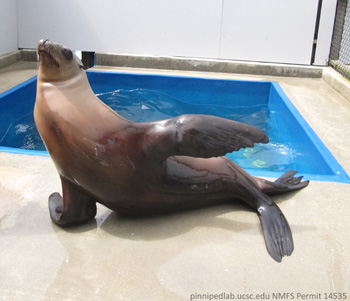Ronan, a California sea lion at UCSC's Long Marine Laboratory, became an Internet sensation last year when UCSC scientists published a paper describing her ability to bob her head in time with rhythmic sounds and music in a variety of tempos (see news story and video). Now she's in the news again as scientists at the annual meeting of the American Association for the Advancement of Science (AAAS) in Chicago discussed her rhythmic feats in a session devoted to "Rhythmic entrainment in non-human animals."
Ronan is the first non-human mammal convincingly shown to be able to keep the beat. Her range and versatility in matching different beats is impressive, according to Peter Cook, who began working with Ronan as a graduate student at UC Santa Cruz. Cook, now a postdoctoral fellow at Emory University, presented his research on Ronan's beat-keeping ability at the AAAS meeting on Saturday, February 15.
"The comparative study of rhythm has undergone a renaissance in recent years, with new methods being attempted and new species tested. It's exciting to be meeting with top scientists in the field at this crucial juncture," he said.
Cook noted that Ronan can move in time to a wide range of rhythmic auditory stimuli with different tempos, including music. "Along with other recent findings, this suggests that the neural mechanisms underpinning flexible beat keeping may be much more widely distributed across the animal kingdom than previously thought," Cook said.
Aside from humans, rhythmic entrainment had previously been seen only in parrots and other birds with a talent for vocal mimicry. This led some researchers to theorize that beat keeping requires a capacity for complex vocal learning. "The idea was that beat keeping is a fortuitous side effect of adaptations for vocal mimicry, which requires matching incoming auditory signals with outgoing vocal behavior," Cook said.
But sea lions are not known to do vocal mimicry and have limited flexibility in the sounds they make. "Ronan's success poses a real problem for the theory that vocal mimicry is a necessary precondition for rhythmic entrainment," Cook said.
Born in the wild in 2008, Ronan was rescued by the Marine Mammal Center in Sausalito in 2009 after she was found on Highway 1 in San Luis Obispo County. She came to Long Marine Lab in January 2010 and joined the Pinniped Cognition and Sensory Systems Laboratory directed by one of Cook's advisers at UCSC, animal behaviorist Colleen Reichmuth.
Scientists once thought that the underpinnings of musical ability were unique to humans. But human musical ability may in fact have foundations that are shared with animals, according to Cook. "People have assumed that animals lack these abilities. In some cases, people just hadn't looked," he said.
This research was supported by an award from the Packard Endowment for Ocean Sciences at UCSC and a National Science Foundation Graduate Student Fellowship to Peter Cook. The Pinniped Lab works with Ronan under National Marine Fisheries Service permit #14535.



